Even in the early 1990s, Wizardry was something of a throwback. Both the Wizardry and Ultima series–the two great and venerable franchises of computer role-playing games–had begun in 1981, but while Ultima was experimenting with 3D movement (Ultima Underworld) and combat-light, story- and world-interactivity-driven games (Ultima VII, the likes of which has still never been replicated), Wizardry was all about dungeon diving, turn-based combat, maddening environment puzzles, and more character builds and items than you could throw a spreadsheet at.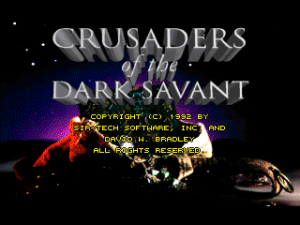
Wizardry was for the hardcore: the players who grudgingly accepted auto-mapping but wanted the quality of the auto-generated maps to be dependent on the skills of the in-game party members, and who were still willing to keep reams of notes to keep the teleporter puzzles straight. Wizardry was for players who didn’t need fancy graphics or in-your-face storytelling getting in the way of combat. In Computer Gaming World‘s February 1991 preview of Wizardry VII: Crusaders of the Dark Savant, writer Alan Emrich goes on about the appearance of trees in a Wizardry game; understandable, since the seventh installment was the first Wizardry to have a world beyond the dungeon at all.
And while Wizardry may never have broadened its appeal, Wizardry VII was a masterpiece of its combat- and puzzle-heavy subgenre, ceaselessly challenging and immense in scope. For my tastes, it’s a bit too much–too much combat, puzzles fascinating but slightly too insane–and yet it remains a game that entrances me.
Largely because of that odd duck that Wizardry traditionally never spent much time on: the story. Let’s discuss why it worked.
The plot of Wizardry VII picks up from the (multiple) endings of Wizardry VI, a castle-crawling dungeon game taking place in a nondescript fantasy world with an occasionally philosophically brooding flavor (we’ll come back to that later). After freeing the land from the Bane King in Wizardry VI‘s finale, the party of voiceless player-created characters is swept away on a spaceship to a distant planet recently rediscovered–thanks to the chaos around the “Cosmic Forge” of the previous game–by the galactic community and purported to hold an artifact of great cosmological significance. The player is sent on a mission to explore this new world and compete against the other galactic factions (including the “herald of change,” the Dark Savant) to recover the artifact in question.
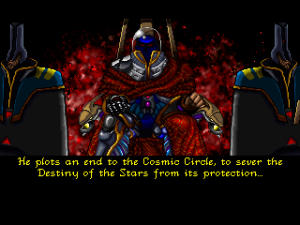 Wizardry VII is unapologetic but consistent about its introduction of science-fiction tropes into a predominantly fantasy environment–spaceships and laser guns are used freely by non-native groups while swords and magic are used by the locals, but technology is described by its effects, not by technical names (the first spaceship the characters encounter is described as a great metal flying beast). Our point of view, despite the lack of elaborate story setup, is made clear–our medieval characters are way out of their element–and a sense of alienation is immediately present.
Wizardry VII is unapologetic but consistent about its introduction of science-fiction tropes into a predominantly fantasy environment–spaceships and laser guns are used freely by non-native groups while swords and magic are used by the locals, but technology is described by its effects, not by technical names (the first spaceship the characters encounter is described as a great metal flying beast). Our point of view, despite the lack of elaborate story setup, is made clear–our medieval characters are way out of their element–and a sense of alienation is immediately present.
With tile graphics largely recycled throughout the game and characters only depicted during combat and conversation (no ambient crowds here!), the primary means of story delivery in Wizardry VII is text.
A Thousand Words Can Be Worth More Than a Picture
David W. Bradley was designer, writer, and programmer on Wizardry VII, making the game the apparent vision of one man. (We’ll come back to that later.) It’s Bradley’s prose that periodically guides the players into his strange world–but keep in mind that the areas are mostly filled with combat encounters or puzzles. Text descriptions are highlights and rewards, far less common than, say, dialogue in a game such as Mass Effect.
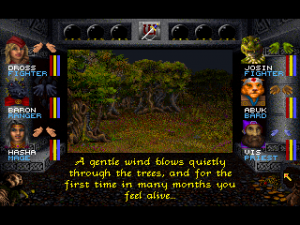 Bradley’s prose is distinctive, with all the positives and negatives that suggests. Often overwrought, it’s also nonetheless evocative and possessed of a certain wan, avuncular humor alongside its philosophical brooding.
Bradley’s prose is distinctive, with all the positives and negatives that suggests. Often overwrought, it’s also nonetheless evocative and possessed of a certain wan, avuncular humor alongside its philosophical brooding.
Below is one relatively simple example, preceding an encounter with a king the player has been seeking in a multi-level dungeon:
Shadows dance upon the walls of the dark and gloomy cathedral, and emptiness pervades the chamber deep within every crevice…
Faded tapestries, illuminated by the candlelight, depict scenes of warring tribes and victorious battles, and you glimmer that these represent eras of history now long passed…
Once this masterful stateroom was no doubt a bustle of activity, filled with endless politics and head-rolling decisions.
Now, only the lone figure silhouetted upon the distant throne, somber, forlorn, staring out as if pondering thoughts a million miles away, breaks through the depression which so clouds this desolate, desperate arena…
Note that the unusual paragraph format and ellipses are a product of how the game displays text, but Bradley works it effectively.
Scenes incorporating dialogue–or more often, monologues–can go on at some length. This is one of several such sequences from the player’s journey into a pseudo-dream realm (and neither the longest nor the strangest encounter there by far–see the linked video below for more):
Sitting upright upon a cushion, drawing smoke through a long supple tube, itself connected to a bulbous vase upon which rests a bowl of burning embers, a sedate munk succulently inhales his voyage into far distant reveries…
As you step near, he breaks the silence:
Life is a mystery…
A puzzle…
A riddle, a rebus, an enigma…
As you live, you discover some of its pieces…
Some you know, as if you had always known…
Others you do not recognize, and discard…
But all is a part of the puzzle…
To unlock its secrets, remember that all is but a piece, and not the puzzle complete…
Each man, each woman, all dwell in a grand collage…
That which you fear, is but a piece which looms in the shadows…
That which you believe, is but a piece that you cling to in safety…
All of this is a part of the rebus of Life…
No one shall ever solve it for you…
No one shall ever know you but you…
To behold the puzzle, is to gaze into the face of the unknown…
To solve the puzzle, is to walk the infinite journey…
Then the smoke billows profusely from his pipe, and soon the room is enclouded with a dense haze…
When the fog lifts, he is gone…
A little pouch is all that remains, tiny on the floor. Reaching to pick it up, you hear his voice whisper inside your head…
Do-dah…
In other places, text is simply used to cap an encounter in a tonally fitting manner. After killing a great sea monster the player heard about much earlier in the game (from a man who failed to slay it):
In the blood-filled waters the leviathan carcass slips back to the depths, a gruesome end to the monsterous legend…
There’ll be no trophy to adorn any marina’s walls, and perhaps this too is how it should be…
After all, real myths are hard to come by…
However one may feel about the quality of the prose (and I confess, I enjoy it despite its faults), he’s clearly providing an atmosphere and pushing at themes the game wouldn’t otherwise convey. Even a game with an unlimited budget for art, sound, and cinematics couldn’t convey Bradley’s ideas so elegantly–an attempt to remake Wizardry VII in the more cinematic style of Dragon Age or Skyrim would fail utterly. The textual element is essential–not a crutch for a game without the technological or budgetary resources to do more, but a key part of the design and vision for a thoughtful, ambitious, occasionally self-deprecating work.
Consider, too, the fact that Bradley’s prose wouldn’t work in other contexts but fits nicely here. A novel in this style might quickly wear out its welcome, but a few paragraphs every hour of gameplay? Perfectly acceptable. Nor, I think, is Bradley’s dialogue–which, again, is primarily monologue–particularly suited to voice acting, but it serves nicely on the screen. (Wizardry Gold–a voiced version of Wizardry VII, released quite some time after the original–does exist. I’m uncertain whether Bradley had any part in it, and I’ve never played it myself, but I’d be curious if my theory about the voice acting holds true.)
In an era when games that look and feel like movies are often considered the height of the art form, games that heavily integrate text tend to be seen as cheap by default. But it’s important to bear in mind that text can be an artistic choice, as well–why privilege the notion of an interactive movie above that of an interactive novel (or an interactive comic, or an interactive music concert?)
But back to Wizardry VII. Text is one way it establishes atmosphere, but not the only way.
Minimalist Worldbuilding and the Geography of Dreams
The setting of Wizardry VII–the planet Guardia–is an enigmatic one. While narration and conversations and set pieces occasionally hint at a long and rich history, it’s a history we’re never given. There’s no in-game codex of lore to teach the player about the origins of the rivalry between the Munk and the Dane. We’re given the sketchiest of outlines of the history of New City, but only because it directly pertains to our quest. The titular Dark Savant has a fantastic visual design, but where he came from and why he’s so driven to overthrow the cosmic status quo is a complete unknown.
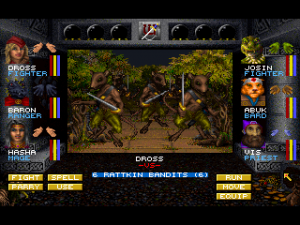 There are a thousand smaller mysteries, as well–the player frees the ghost of a cursed old woman through an act of kindness, but never learns who she was or why she was cursed. And what of the mysteries implied by the strange names of random items and monsters? What’s the story behind the imprisoned (optional boss monster) “The Fiend of 9 Worlds”? Why can the “Cane of Corpus” only be used by a faerie ninja?
There are a thousand smaller mysteries, as well–the player frees the ghost of a cursed old woman through an act of kindness, but never learns who she was or why she was cursed. And what of the mysteries implied by the strange names of random items and monsters? What’s the story behind the imprisoned (optional boss monster) “The Fiend of 9 Worlds”? Why can the “Cane of Corpus” only be used by a faerie ninja?
For the most part, I wouldn’t want those answers. A sense of mystery and wonder is integral to the atmosphere Wizardry VII aims to create. The player isn’t meant to conquer Guardia, but to arrive on a strange new planet (literally–remember, the characters have been transported across the galaxy without understanding any of it) and take part in a strange, mythical, ineffable journey.
There’s a strong trend of worldbuilding in post-Tolkien fantasy–settings with laboriously crafted histories and geographies that audiences are meant to enjoy learning as they go. This is especially true in the video game world, with its many Dungeons & Dragons-inspired universes. Implied settings are regaining a level of respectability, but are more common in action games than in full-fledged RPGs–I can’t recall the last RPG I played in which as little of the setting was ever revealed as in Wizardry VII.
Wizardry VII plays to its technical strengths in this regard, as well. The engine is incapable of rendering other characters when not in an encounter state (that is, in combat or conversation). That means cities always feel empty, and the text emphasizes that locales have been abandoned, shops shuttered, and so forth. Encounters with other characters are rare and always important. Guardia is a lonely world where individuals are more important than societies.
(There’s another point to be made in how Wizardry VII treats non-player characters: perhaps a dozen or more characters from the major factions wander the world semi-randomly, pursuing some of the same artifacts the player must acquire. Entirely offscreen, the NPCs meet, fight, trade objects, kill one another, and seize treasures before the player can–and in turn must occasionally be located by the player in order to acquire an object the player missed. While often less exciting than it sounds in theory, this aspect gives the NPCs a sense of life and richness of story that’s never explained; knowing only that Rodan Lewarx died fighting K’Borra T’Rang over the Legend map, it’s hard not to wonder and imagine what exactly happened.)
A Fantasy of Ideas
Fantasy that emphasizes worldbuilding also tends to de-emphasize another classic fantasy trait: the willingness to use fantasy stories as a means of wrestling directly with Big Ideas. One of the advantages of fantasy as a genre is that a story dealing thematically with (for example) the notion of growing old doesn’t need to drape itself in metaphors and subtlety–it can create a scenario in which the protagonists wrestle with Age Itself, embodied in flesh and wreaking havoc with a magic hourglass.
Wizardry VII wants to talk about big ideas and it’s not shy about it. Aside from the stylized monologues (which, as in the example above, often meander around questions of existence), it’s not far into the game that the player meets “the Spirit of Life, and the spirit that unites all creation and destruction”–on a sub-quest, no less. The “maps” the player must collect (text pieces which primarily serve as clues to some of the games nastier puzzles) are formulated as spiritual and philosophical treatises on life’s journey. The true nature of the game’s ultimate artifact, too, is in line with Wizardry VII‘s interests.
In a more grounded game–in a less enigmatic, dreamlike setting, or a game where voice acting and extensive cinematics rendered characters with startling realism–Wizardry VII‘s fantasy of ideas could easily come across as pompous and overblown. But with the unique support of Bradley’s prose and careful worldbuilding that prioritizes atmosphere above fact, it’s the charming core of a game that often feels more Lewis Carroll than George R. R. Martin.
I mentioned above that I’d come back to the fact that Wizardry VII is largely one man’s vision, and I suspect Bradley’s overwhelming presence is vital to making the game’s fantasy of ideas function. There’s a sincerity and a consistency to the themes Bradley explores that would likely be difficult to maintain in a game created (or written!) by a staff of hundreds. When you privilege theme above character, you must be prepared to treat thematic consistency with the same reverence many writers hold for characters–but getting a group of creators on the same page regarding a character can be much easier than doing the same with a grand philosophical notion.
Taking Flight (and Closing Thoughts)
None of this is to say that Wizardry VII‘s narrative (or its gameplay, for that matter) is flawless. Bradley’s sense of humor and winks to the audience occasionally fall flat or jar, and the game’s treatment of women and minorities leaves much to be desired. The big ideas, while fun, aren’t likely to change anyone’s religion, and likely aren’t meant to. As mentioned above, one’s tolerance for Bradley’s prose may determine how much one enjoys the narrative overall.
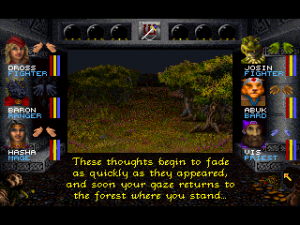 But because of its integration of textual elements, its minimalist worldbuilding and transformation of technical limitations into thematic triumphs, and its interest in tackling subject matter rarely hit head-on in fantasy computer role-playing games, it works in a way that few other games do–and it works successfully. That makes it worthy of consideration.
But because of its integration of textual elements, its minimalist worldbuilding and transformation of technical limitations into thematic triumphs, and its interest in tackling subject matter rarely hit head-on in fantasy computer role-playing games, it works in a way that few other games do–and it works successfully. That makes it worthy of consideration.
For those intrigued, Wizardry VII is available in digital form (packaged along with the “upgraded” Wizardry Gold–which, as mentioned, I can’t pass judgment on–and Wizardry VI) from GOG.com and Steam. Wizardry VI is also the work of Bradley, and while clearly the creation of the same man is ultimately somewhat less ambitious and even more technically dated.
Wizardry 8 picks up the cliffhanger ending of Wizardry VII, but it isn’t the work of Bradley, who had moved on to other companies and other projects. Although it’s a fine game in many respects, the absence of his narrative touch is greatly felt. In truth, I’ve never finished Wizardry 8… I intend to at some point, but without philosophical meanderings and the promise of life’s great secrets, it hardly feels like the same world, even sharing the same characters.
Really, Wizardry VII‘s own ending resolves quite a bit, and what’s left? The promise of another journey into space, secrets of the gods still untapped–perhaps leaving that bit of mystery intact is consistent with Bradley’s vision after all.
Special thanks to Øystein Pettersen, whose intricate walkthrough helped me track down the text segments reprinted here. My official hint book–which, madly and wonderfully, replicates most of the game text–was out of reach.
